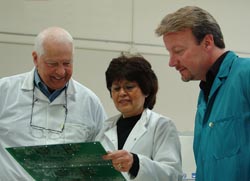Biamp president Ralph Lockhart (left) examines with Gloria Thomas (center) and Alan Hummel the RoHS-compliant results of the company's advanced production line at Biamp's Beaverton, OR R&D and Manufacturing Center.NAME: Ralph Lockhart
TITLE: President
OVERTIME: Biamp treats R&D as an investment with a return in the form of better functionality or performance.
SCN: When I visited the Biamp headquarters this summer, you said, "We're in commercial audio, but our roots are in rock and roll. We really care about the sound." Would you care to elaborate on this sentiment?
Ralph Lockhart: Biamp Systems started in the live music business, and so our equipment had to sound good because the program material it handled was usually at high sound-pressure levels through full-range speaker systems. Consistent, quality sound was the singular reason why our customers bought our equipment in the first place and today, providing consistent, quality sound is an essential requirement of our products. If we fail to meet this quality threshold, it will reflect on the consultants who specify our products and the contractors who purchase and integrate them, and we can't have that!
Most of the manufacturers in the commercial sound business where Biamp Systems resides today have roots in speech reinforcement only-generally at much lower levels and typically through six- or eight-inch ceiling speakers, where full-range, uncolored, true sound simply isn't as important. The culture of 'true sound' remains a key element at Biamp Systems. We've invested heavily in R&D and manufacturing to maintain the distinction and we've built upon the sound platform by extending our commitment to quality to all other areas of the business from training and support to inventory and administration. We've also continually evolved the product feature set to provide contractors, consultants, and their customers with functionality and connectivity so that they, too, can stay ahead of their competition.
SCN: Can there ever be too much investment in engineering?
RL: I think you have to look at R&D as an investment and not simply an expenditure. We approach it with care and we expect to derive a return in the form of better functionality or performance that will put Biamp Systems in a different league from our competition and so contribute to our commercial success. I think it's also important to recognize that contractors and consultants also invest in our products and in their relationship with us. They invest their reputation on our systems, invest their time on learning our programming, and their money on not having to go back to customers again and again on maintenance and support. We believe it's incumbent on us to make the products continually better and/or less expensive to make our customers better and more efficient-or someone else will.
From a more practical view I suspect there is, for each company, some point at which increasing the amount of engineering effort can't be effectively managed and therefore is no longer an 'investment' in the best sense of that term.
SCN: How would you account for the longevity of Biamp's management team and the loyalty of its employees? You've had minimal turnover in the upper ranks, and even those who work on the production line have a personal relationship with you.
RL: By luck, or hopefully some skill, we have attracted a core of outstandingly honest, talented, hardworking people. Fortunately, good people tend to attract other good people. Biamp Systems is above all else a collection of individuals, and it's a great place to work-we strongly embrace a culture that everyone, everyone, is treated with respect and courtesy. Quite simply, there are no unimportant jobs here.
SCN: How would you finish the following sentences?
Training should be... ongoing, un-ending, relevant...and fun!
It better work right out of the box, or... we all-end-user, integrator, consultant, and Biamp-lose. So why not do everything possible to avoid a no-win situation?
The global market...is different, and the same, everywhere. Different in the sense that language, regulations, customs, etc., vary from country to country and should be recognized and respected. The same in the sense that everyone wants to buy products which are high quality, reliable, do everything they're represented to do (and a little more), and are supported by the manufacturer without reservation.
Video without audio is...like lip-reading. A lot, maybe most, of the information gets lost.
It rains a lot in Portland, but...what the heck, the rain is what keeps everything so clean and green. And, while we like to keep it a secret, it doesn't rain in the summer. And the summers are beautiful!










